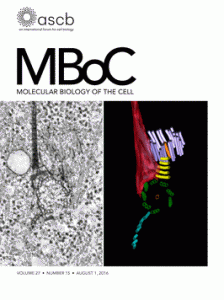 Authors of a molecular biology paper have pulled it after realizing that their cell lines were contaminated.
Authors of a molecular biology paper have pulled it after realizing that their cell lines were contaminated.
According to the notice in Molecular Biology of the Cell (MBoC), the contamination occurred by “unknown means” in the senior authors’ laboratory, who told us the mistake was a difficult one to catch. He added that they discovered the problem after other researchers published conflicting results.
He also noted that the contaminated cell lines were not used for experiments in any other papers.
Here’s the retraction notice, issued on August 1:
The authors of “Lectin-deficient Calreticulin Retains Full Functionality as a Chaperone for Class I Histocompatibility Molecules” (Mol. Biol. Cell [2008] 19, 2413–2423; originally published in MBoC In Press as 10.1091/mbc.E07-10-1055) wish to retract their paper. They have provided the following statement:
Our paper reported that two lectin-deficient mutants of calreticulin retained full ability to support the biogenesis of class I histocompatibility molecules and also bound to the same spectrum of newly synthesized glycoproteins as the wild-type chaperone. During recent efforts to extend this work, we were unable to replicate the results. An investigation detected evidence of contaminating wild-type calreticulin in the original mutant cell lines, contamination that occurred by unknown means in the senior author’s laboratory. Consequently, we wish to retract the paper. We continue to work on the nature of the interactions of calreticulin with client glycoproteins and will be publishing thoroughly validated results on this issue in the near future. We offer our most sincere apologies to the scientific community for any difficulties that may have been experienced. All of the authors have agreed to this retraction.
The 2008 paper has been cited 43 times, according to Thomson Reuters Web of Science.
David Williams from the University of Toronto, the last author of the paper, told us the same cell lines were not used in experiments in other studies, adding:
I’ve discussed the incident with the other authors of the paper and I believe it was an accidental contamination of the mutant cells with wild type. How this occurred and who specifically was responsible remains unknown.
Williams added that this was a difficult mistake to catch because
the mutant plasmids possessed the correct sequences at the time of transfection and the contaminated cells exhibited a phenotype that was reasonable based on a variety of in vitro studies published previously by our lab and others. We were only alerted to the possibility of error when other groups published studies in cells that yielded different results. We then went back to investigate the discrepancy, comparing newly created mutant cell lines to the original mutant cell lines, and discovered the error.
Williams noted that his lab has added “rigorous” procedures to minimize future accidental contaminations of cell lines.
Even though he was alerted to the problem when researchers published conflicting findings, Williams said that he doesn’t think progress in the field was “substantially delayed” due to the mistakes in the MBoC paper.
As our co-founders note in their column for STAT, thousands of studies are known to have used incorrect or contaminated cell lines, yet that’s rarely a reason for journals to issue a correction — let alone a retraction. In a poll we ran last December, 55% of readers said journals should issue corrections for contaminated or incorrectly identified cell lines, whilst 40% felt that a retraction was the better option.
With that in mind, we’d like to give these authors credit for “doing the right thing.”
Like Retraction Watch? Consider making a tax-deductible contribution to support our growth. You can also follow us on Twitter, like us on Facebook, add us to your RSS reader, sign up on our homepage for an email every time there’s a new post, or subscribe to our new daily digest. Click here to review our Comments Policy. For a sneak peek at what we’re working on, click here.